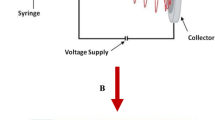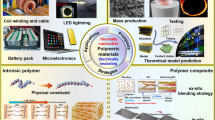Abstract
With the extensive use of high-power electronic appliances, polymer-based thermal insulation composites with excellent thermal properties are utilized in the field of heat management with the aim of improving heat dissipation. Due to the high thermal conductivity and good electrical insulation, boron nitride (BN) is rendered as a superior candidate material for thermally conductive fillers. However, the thermal conduction of the composites is inevitably hampered by the interfacial resistance between BN and the polymer matrix. In this work, BN surface was modified by dopamine hydrochloride (PDA) and phenyltrimethoxysilane to enhance its interface compatibility with the polymer matrix. Meanwhile, by applying pressure to the composites during processing, BN grains inside the composite were well aligned to the direction parallel to the heat flow, thereby improving the through-plane thermal conductivity. When the filler content is fixed at 31 vol%, the thermal conductivity of the phenyl silicone rubber (PVMQ)-based composite prepared from modified BN (mark as M-BN/PVMQ) reaches 1.642 W/(m·K), nearly equal to nine times the value for the pure PVMQ matrix (0.18 W/(m·K)). Furthermore, in a nitrogen atmosphere, the initial decomposition temperature (T5%) reaches 512 °C, 172 °C higher than that of pure PVMQ (340 °C). The improved thermal stability of the composites prepared from modified BN resulted from the enhanced interfacial effect, which was analyzed by thermogravimetric infrared gas mass spectrometry system (TG-IR-GC/MS). The high thermal conductivity and stability enable the M-BN/PVMQ composite a promising material for thermal management.
















Similar content being viewed by others
References
Al-Enizi AM, Shaikh SF, Ubaidullah M, Ghanem MA, Mane RS (2020) Self-grown one-dimensional nickel sulfo-selenide nanostructured electrocatalysts for water splitting reactions. Int J Hydrogen Energ 45:15904–15914
Ubaidullah M, Al-Enizi AM, Shaikh S, Ghanem MA, Mane RS (2020) Waste PET plastic derived ZnO@NMC nanocomposite via MOF-5 construction for hydrogen and oxygen evolution reactions. J King Saud Univ Sci 32:2397–2405
Rahman NA, Hanifah SA, Mobarak NN, Ahmad A, Ludin NA, Bella F, Su’Ait MS (2021) Chitosan as a paradigm for biopolymer electrolytes in solid-state dye-sensitised solar cells. Polymer 230:124092
Galliano S, Bella F, Bonomo M et al (2021) Xanthan-based hydrogel for stable and efficient quasi-solid truly aqueous dye-sensitized solar cell with cobalt mediator. Sol RRL 5:2000823
Wei Y, Zhou HJ, Deng H, Ji WJ, Tian K, Ma ZY, Zhang KY, Fu Q (2022) “Toolbox” for the processing of functional polymer composites. Nano-Micro Lett. https://doi.org/10.1007/s40820-021-00774-5
Hu YY, Guan RT, Zhang S et al (2022) A convenient fluorescence sensor of tetracycline based on B, N codoped carbon dots/polymer composite film. Food Chem 372:131287
Abdalla A, Jones W, Flint MS, Patel BA (2021) Bicomponent composite electrochemical sensors for sustained monitoring of hydrogen peroxide in breast cancer cells. Electrochim Acta 398:139314
Hanamura M, Sawada T, Serizawa T (2021) In-paper self-assembly of cellulose oligomers for the preparation of all-cellulose functional paper. ACS Sustain Chem Eng 9:5684–5692
Amici J, Torchio C, Versaci D et al (2021) Nanosponge-based composite gel polymer electrolyte for safer Li-O2 batteries. Polymers 13:1625
Ubaidullah M, Ahmed J, Ahamad T, Shaikh SF, Alshehri SM, Al-Enizi AM (2020) Hydrothermal synthesis of novel nickel oxide@nitrogenous mesoporous carbon nanocomposite using costless smoked cigarette filter for high performance supercapacitor. Mater Lett 266:127492
Al-Enizi AM, Ubaidullah M, Ahmed J, Ahamad T, Ahmad T, Shaikh SF, Naushad M (2020) Synthesis of NiOx@NPC composite for high-performance supercapacitor via waste PET plastic-derived Ni-MOF. Compos Part B 73:232–241
Al-Enizi AM, Ahmed J, Ubaidullah M, Shaikh SF, Ahamad T, Naushad M, Zheng GF (2020) Utilization of waste polyethylene terephthalate bottles to develop metal-organic frameworks for energy applications: a clean and feasible approach. J Clean Prod 248:119251
Zeng HX, Wu JY, Pei HJ, Zhang YK, Ye YS, Liao YG, Xie XL (2021) Highly thermally conductive yet mechanically robust composites with nacre-mimetic structure prepared by evaporation-induced self-assembly approach. Chem Eng J 405:126865
Bai X, Zhang CX, Zeng XL, Ren LL, Sun R, Xu JB (2021) Recent progress in thermally conductive polymer/boron nitride composites by constructing three-dimensional networks. Compos Commun 24:100650
Ma HQ, Gao B, Wang MY, Yuan ZY, Shen JB, Zhao JQ, Feng YK (2021) Strategies for enhancing thermal conductivity of polymer-based thermal interface materials: a review. J Mater Sci 56:1064–1086. https://doi.org/10.1007/s10853-020-05279-x
Guerra V, Wan CY, McNally T (2019) Thermal conductivity of 2D nano-structured boron nitride (BN) and its composites with polymers. Prog Mater Sci 100:170–186
Yu CP, Zhang J, Li Z et al (2017) Enhanced through-plane thermal conductivity of boron nitride/epoxy composites. Compos Part A 98:25–31
Song N, Yang JW, Ding P, Tang SF, Shi LY (2015) Effect of polymer modifier chain length on thermal conductive property of polyamide 6/graphene nanocomposites. Compos Part A 73:232–241
Gu JW, Guo YQ, Lv ZY, Geng WC, Zhang QY (2015) Highly thermally conductive POSS-g-SiCp/UHMWPE composites with excellent dielectric properties and thermal stabilities. Compos Part A 78:95–101
Han JK, Du GL, Gao WW, Bai H (2019) An anisotropically high thermal conductive boron nitride/epoxy composite based on nacre-mimetic 3D network. Adv Funct Mater 29:1900412
Tian ZL, Sun JJ, Wang SG, Zeng XL, Zhou S, Bai SL, Zhao N, Wong CP (2018) A thermal interface material based on foam-templated three-dimensional hierarchical porous boron nitride. J Mater Chem A 6:17540–17547
Wei BJ, Zhang L, Yang SQ (2021) Polymer composites with expanded graphite network with superior thermal conductivity and electromagnetic interference shielding performance. Chem Eng J 404:126437
Shen CX, Wang H, Zhang TX, Zeng Y (2019) Silica coating onto graphene for improving thermal conductivity and electrical insulation of graphene/polydimethylsiloxane nanocomposites. J Mater Sci Technol 35:36–43
Hu Y, Chiang SW, Chu XD et al (2020) Vertically aligned carbon nanotubes grown on reduced graphene oxide as high-performance thermal interface materials. J Mater Sci 55:9414–9424. https://doi.org/10.1007/s10853-020-04681-9
Liang X, Yang YQ, Dai FH, Wang CA (2019) Orientation dependent physical transport behavior and the micro-mechanical response of ZnO nanocomposites induced by SWCNTs and graphene: importance of intrinsic anisotropy and interfaces. J Mater Chem C 7:1208–1221
Duan GY, Cao YT, Quan JY, Zeng X, Hu ZM, Wang Y, Yu JR, Zhu J (2020) Bioinspired construction of BN@polydopamine@Al2O3 fillers for preparation of a polyimide dielectric composite with enhanced thermal conductivity and breakdown strength. J Mater Sci 55:8170–8184. https://doi.org/10.1007/s10853-020-04596-5
Wu K, Wang JM, Liu DY, Lei CX, Liu D, Lei WW, Fu Q (2020) Highly thermoconductive, thermostable, and super-flexible film by engineering 1D rigid rod-like aramid nanofiber/2D boron nitride nanosheets. Adv Mater 32:1906939
Zhou WY, Chen QG, Sui XZ, Dong LN, Wang ZJ (2015) Enhanced thermal conductivity and dielectric properties of Al/β-SiCw/PVDF composites. Compos Part A 71:184–191
Machrafi H, Lebon G, Iorio CS (2016) Effect of volume-fraction dependent agglomeration of nanoparticles on the thermal conductivity of nanocomposites: applications to epoxy resins, filled by SiO2, AlN and MgO nanoparticles. Compos Sci Technol 130:78–87
Bian YB, Liu MN, Ke GS, Chen YG, DiBattista J, Chan E, Yang YM (2015) Aluminum nitride thin film growth and applications for heat dissipation. Surf Coat Technol 267:65–69
Golberg D, Bando Y, Huang Y, Terao T, Mitome M, Tang CC, Zhi CY (2010) Boron nitride nanotubes and nanosheets. ACS Nano 4:2979–2993
Kuang ZQ, Chen YL, Lu YL, Liu L, Hu S, Wen SP, Mao YY, Zhang LQ (2015) Fabrication of highly oriented hexagonal boron nitride nanosheet/elastomer nanocomposites with high thermal conductivity. Small 11:1655–1659
Kim K, Kim M, Kim J (2014) Fabrication of UV-curable polyurethane acrylate composites containing surface-modified boron nitride for underwater sonar encapsulant application. Ceram Int 40:10933–10943
Xiao C, Chen L, Tang YL, Zhang X, Zheng K, Tian XY (2019) Enhanced thermal conductivity of silicon carbide nanowires (SiCw)/epoxy resin composite with segregated structure. Compos Part A 116:98–105
Muratov DS, Kuznetsov DV, Il Inykh IA, Burmistrov IN, Mazov IN (2015) Thermal conductivity of polypropylene composites filled with silane-modified hexagonal BN. Compos Sci Technol 111:40–43
Cho H, Nakayama T, Suematsu H et al (2016) Insulating polymer nanocomposites with high-thermal-conduction routes via linear densely packed boron nitride nanosheets. Compos Sci Technol 129:205–213
Chen XL, Lim JSK, Yan WL, Guo F, Liang YN, Chen H, Lambourne A, Hu X (2020) Salt template assisted BN scaffold fabrication toward highly thermally conductive epoxy composites. ACS Appl Mater Interfaces 12:16987–16996
An D, Duan XY, Cheng SS et al (2020) Enhanced thermal conductivity of natural rubber based thermal interfacial materials by constructing covalent bonds and three-dimensional networks. Compos Part A 135:105928
Yuan J, Qian XT, Meng ZC, Yang B, Liu ZQ (2019) Highly thermally conducting polymer-based films with magnetic field-assisted vertically aligned hexagonal boron nitride for flexible electronic encapsulation. ACS Appl Mater Interfaces 11:17915–17924
Chen J, Huang XY, Sun B, Wang YX, Zhu YK, Jiang PK (2017) Vertically aligned and interconnected boron nitride nanosheets for advanced flexible nanocomposite thermal interface materials. ACS Appl Mater Interfaces 9:30909–30917
Xue Y, Li XF, Wang HS, Zhao F, Zhang DH, Chen YF (2019) Improvement in thermal conductivity of through-plane aligned boron nitride/silicone rubber composites. Mater Design 165:107580
Zhong B, Zou JX, An LL et al (2019) The effects of the hexagonal boron nitride nanoflake properties on the thermal conductivity of hexagonal boron nitride nanoflake/silicone rubber composites. Compos Part A 127:105629
Li SQ, Wang HX, Mao HQ, Li L, Shi HF (2021) Enhanced thermal management performance of comb-like polymer/boron nitride composite phase change materials for the thermoregulated fabric application. J Energy Storage 40:102826
Lee W, Kim J (2020) Enhanced through-plane thermal conductivity of paper-like cellulose film with treated hybrid fillers comprising boron nitride and aluminum nitride. Compos Sci Technol 200:108424
Yıldız G, Akkoyun M (2021) Thermal and electrical properties of aluminum nitride/boron nitride filled polyamide 6 hybrid polymer composites. J Appl Polym Sci 138:50516
Qu JY, Fan L, Mukerabigwi JF, Liu C, Cao Y (2021) A silicon rubber composite with enhanced thermal conductivity and mechanical properties based on nanodiamond and boron nitride fillers. Polym Composite 42:4390–4396
Lin YS, Hsu SLC, Ho TH, Jheng LC, Hsiao YH (2020) Preparation and thermomechanical properties of ketone mesogenic liquid crystalline epoxy resin composites with functionalized boron nitride. Polymers 12:1913
Liu Z, Li JH, Liu XH (2020) Novel functionalized BN nanosheets/epoxy composites with advanced thermal conductivity and mechanical properties. ACS Appl Mater Interfaces 12:6503–6515
Meng QS, Han SS, Liu TQ, Ma J, Ji SD, Dai JB, Kang HL, Ma J (2020) Noncovalent modification of boron nitrite nanosheets for thermally conductive, mechanically resilient epoxy nanocomposites. Ind Eng Chem Res 59:20701–20710
Ryu JH, Messersmith PB, Lee H (2018) Polydopamine surface chemistry: a decade of discovery. ACS Appl Mater Interfaces 10:7523–7540
Muhammad M, Hu S, Ma R et al (2020) Enhancing the corrosion resistance of Q235 mild steel by incorporating poly(dopamine) modified h-BN nanosheets on zinc phosphate-silane coating. Surf Coat Technol 390:125682
Nan BF, Wu K, Chen WL, Liu YC, Zhang Q, Lu MG (2020) Bioinspired modification strategy to improve thermal conductivity of flexible poly(vinyl alcohol)/nanodiamond nanocomposite films for thermal management applications. Appl Surf Sci 508:144797
Yang D, Ni YF, Kong XX, Gao DH, Wang Y, Hu TT, Zhang LQ (2019) Mussel-inspired modification of boron nitride for natural rubber composites with high thermal conductivity and low dielectric constant. Compos Sci Technol 177:18–25
Fujihara T, Cho H, Nakayama T, Suzuki T, Jiang WH, Suematsu H, Kim HD, Niihara K (2012) Field-induced orientation of hexagonal boron nitride nanosheets using microscopic mold for thermal interface materials. J Am Ceram Soc 95:369–373
Agari Y, Ueda A, Nagai S (1993) Thermal conductivity of a polymer composite. J Appl Polym Sci 49:1625–1634
He C, Li BQ, Ren Y, Lu W, Zeng YB, He WD, Feng AC (2019) How the crosslinking agent influences the thermal stability of RTV phenyl silicone rubber. Materials 12:88
Radhakrishnan TS (1999) New method for evaluation of kinetic parameters and mechanism of degradation from pyrolysis—GC studies: thermal degradation of polydimethylsiloxanes. J Appl Polym Sci 73:441–450
Grassie N, Francey KF (1980) The thermal degradation of polysiloxanes—Part 3: Poly(dimethyl/methyl phenyl siloxane). Polym Degrad Stabil 2:53–66
Acknowledgements
This work was supported by the Shandong Provincial Natural Science Foundation (Grant No. ZR2020LFG007).
Author information
Authors and Affiliations
Contributions
M Sheng contributed to conceptualization, investigation, writing–original draft, and writing–review and editing. R Yang performed writing–original draft, data curation and investigation. H Gong contributed to writing—reviewing and editing, and funding acquisition. Y Zhang performed investigation and supervision. X Lin and J Jing carried out investigation.
Corresponding authors
Ethics declarations
Conflict of interest
The authors declare that they have no known competing financial interests or personal relationships that could have appeared to influence the work reported in this paper.
Additional information
Handling Editor: Catalin Croitoru.
Publisher's Note
Springer Nature remains neutral with regard to jurisdictional claims in published maps and institutional affiliations.
Supplementary Information
Below is the link to the electronic supplementary material.
Rights and permissions
About this article
Cite this article
Sheng, M., Yang, R., Gong, H. et al. Enhanced thermal conductivity and stability of boron nitride/phenyl silicone rubber composites via surface modification and grain alignment. J Mater Sci 57, 5805–5824 (2022). https://doi.org/10.1007/s10853-021-06860-8
Received:
Accepted:
Published:
Issue Date:
DOI: https://doi.org/10.1007/s10853-021-06860-8




